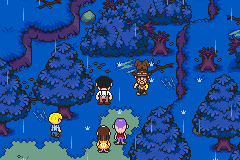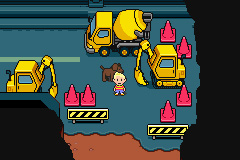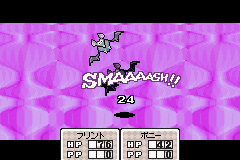How do you review a game as special as Mother 3?
It’s been 14 years since the final entry in Shigesato Itoi’s Mother series released on the Game Boy Advance in Japan, and we’re still pining after an official Western release. Those who have managed to play it are falling over themselves to praise it, while those who haven’t lap up every detail on the series, faithfully waiting for that sacred announcement. Will it come one day? I sure hope so. But I couldn’t wait any longer, so 14 years after it was first released, and two podcast episodes later, I finally beat Mother 3. And I haven’t stopped thinking about it since.
Split into 8 chapters, the game begins with Lucas and his twin brother Claus staying at their grandfather’s house with their mother, Hinawa. But within hours, their idyllic life is shattered by the Pig Mask Army’s invasion of their home, Tazmily Village. This kickstarts a series of devastating events that change the lives of Lucas and the residents of Tazmily forever. The first four chapters each follow a different character as these events unfold, and the latter half of the game follows a more traditional “save the world” quest. Compared to the first two games, I think this entry gives the main characters more personality and agency. Mother 3‘s core cast of characters are all considered outsiders by the game’s second half, and they are all unremarkable people. Lucas is a “crybaby,” Kumatora is abrasive and “unladylike,” and Duster smells and has a clubbed foot, but instead of being pushed aside, these characters band together to help save the world.
If you’re not aware of this game’s reputation, you’d be forgiven for thinking everything is all cute and cuddly from its Peanuts-style visuals. It’s one of the best looking games on Nintendo’s handheld because of how vibrant and colourful the locations are the expressive character sprites. Even with a heavy and dark narrative tone at times, it’s utterly charming to look at. This visual dissonance with the tone really helps, because even if you’ve played EarthBound Beginnings or EarthBound, you do not expect some of the horrible things that happen in this game.

It’s this tone that sets the game apart from its predecessors. Yes, it’s still hilarious and still a biting satire, but the story is permeated by grief. The first hour alone sets the tone with hilarious character names and heartwarming family bonding all ripped apart by death and destruction. I remember watching as Flint, Lucas’ father, slipped into his silent rage as his friends and kids watched him break down. The lump in my throat as I watched a man grieve for what he’d lost, what he’d let slip through his hands, was a painful reminder of my own grief, as well as how others I know had dealt with loss. Mother 3 is unashamed to explore these kinds of themes head-on, tugging at your heartstrings all the way, perhaps famously right to the end. That end sequence is like an icy dagger to the heart, and no matter how much you know about it beforehand, it’s still painful yet beautiful to play through.
Much of this story is told without words, and often incredibly effectively. The beginning of Chapter 4 stands out in my mind vividly, as it bluntly depicts the change in Tazmily Village over 3 years. Shops that once only traded or gave away goods now relied on money; almost everyone has a Happy Box (essentially a TV) inside their home, and many are glued to watching the screens; the dirt paths are now paved over with roads and railways. The residents have been manipulated into thinking that money solves all problems and, as a result, the community spirit has been destroyed. This town was the heart of the game and, despite the pain of Flint and Lucas’ family, it felt like a safe space slowly distorted before my very eyes. I was shocked. The image of New Pork City and the decadence of its leader and the Pig Mask Army are a stark contrast to the game’s humble beginnings too, and it’s unsettling walking in there for the first time to be slapped in the face with vibrant lights and imposing buildings. It makes consumerism unsettling and ugly, and I honestly felt sick.
I applaud Shigesato Itoi and the team for outright rejecting consumerism and criticising it so bluntly. These scenes say so much in just a few minutes, and the message continues to resonate throughout the story. So many focus on Mother 3‘s more difficult moments — and they are absolutely worth talking about — but it’s this uncomfortable balance between humour and the horrific, and the subtle middle-finger the game gives to consumerism, and how the promise of more can pollute minds and break up communities and families, that sticks with me.

Playing the game is pretty much like playing the previous two games, and unfortunately, it retains a few archaic elements. For one, characters have their own individual inventories with a pretty tight limit in each, especially when certain characters only get their full utility by wielding usable items. You can store items via a frog (not a telephone, by calling your dad), but you have to select each item individually and cycle through the inventories every time for each item. Even for 2006, this is an incredibly annoying cycle.
The other problem is knowing where to go. Generally, Mother 3 places your party near the next location or gives you a vague idea of where to go next. But it’s just that: vague. Most of the game is fairly linear (especially the first six chapters), but when you’re told to go to a new place that you’ve never been to before, that’s where things can get a little wearisome. Chapter 7 suffers the most because it’s the most open and the longest, where you’re tasked with travelling across the Nowhere Islands to pull out “Needles.” Getting to Tanetane Island in particular is unusual, as you have to travel underwater by walking into a specific part of the ocean and then traverse the seabed while constantly stopping to refill on oxygen.
I don’t think I was ever as frustrated as I was at the beginning of EarthBound or for the entirety of EarthBound Beginnings, but those roots are still very much ingrained here, despite Mother 3 releasing 11 years after the last game. Yet I don’t think this is a series that aims to be fun, instead maintaining the core RPG mechanics as a callback to when the series was a Dragon Quest pastiche.
Even so, there are a few things that have been fine-tuned, mostly with combat. For one, the rolling health aspect from EarthBound feels a lot tighter and a lot more crucial to manipulate. A few boss fights really take you by surprise, and timing your healing perfectly is sometimes the difference between winning and losing. This extra tactical layer made it really fun to engage in what are otherwise simple turn-based battles.

Another aspect is brand new to the series, and that’s the musical combo system. Characters can combo their normal attacks when it’s their turn to attack if you time pressing the attack button to the beat of the background music, racking up to 16 hits. You can make this easier by putting the enemy to sleep, which lets you hear their heartbeat, which is in-sync with the music. Some tracks are much easier to follow than others, but some of the “beats” are definitely not in time, and if you’re unlucky and can’t put the enemy to sleep, you just have to try your best. It’s another simple layer of strategy, but other than that, the battle system is largely unchanged from EarthBound. And I don’t think it needed to change much either; these additions work well.
Speaking of music, Shogo Sakai has done a wonderful job on an absolutely huge soundtrack with over 250 unique tracks. From “Love Theme,” the game’s main theme and central motif, to the multitude of battle tracks, there’s ample variety and nothing feels repetitive. The sounds that Sakai manages to draw out of the GBA’s sound chip are catchy, and the music goes from whimsical to imposing at the drop of a hat. As far as GBA soundtracks go, it rivals the Golden Sun series as one of the best.
In some ways, I think Mother 3 has been undersold to the world. Yes, it’s a poignant story that teaches the player about grief; it celebrates the power of mothers and family and community; and it’s desperately sad and funny. But the main thing I take away from Mother 3 is its anti-consumerist message, which is deftly delivered, sandwiched between the traumatic events at the beginning and end of the game. It’s a game that’s unafraid to let the images speak for themselves. I’m honestly surprised I hadn’t heard more or played it sooner. It still feels striking over 14 years later, in a world where consumerism and capitalism are king and few media outlets tackle the issue head-on. For that alone, it deserves recognition. When we (hopefully) get Mother 3 officially in English, I’ll be one of the first to return to the Nowhere Islands.



